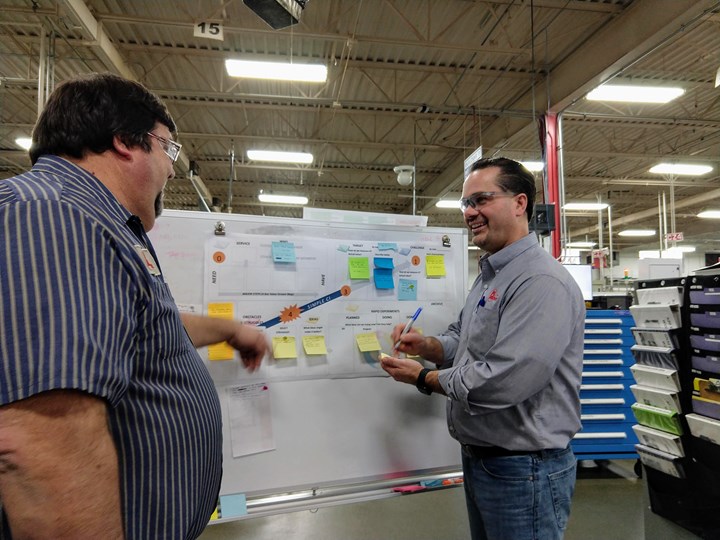What will you learn about continuous improvement in this article that features CNC machine shop managers in the know? Find out in this video.
Dan Vermeesch has a unique perspective on how his company, Micron Manufacturing (Grand Rapids, Michigan), seemed to appear before it implemented continuous improvement processes.
“We were like one of the penguins standing huddled against the cold trying to push its way toward the middle where it’s warmer and safer,” says Mr. Vermeesch, the company’s now-former plant manager. “Today, we are the one near the front of the pack, wearing moon boots, a parka and a fuzzy hat.”

Dan Vermeesch, former plant manager at Micron Manufacturing
Translation: Micron Manufacturing used to be indistinguishable from other companies in the industry, but no more. The shop now has no shortage of skilled labor because it’s a company people want to work for. In fact, Micron’s management team now shares its continuous improvement insight with the industry by offering to teach other companies what it has learned.
When a company commits to a continuous improvement plan, it becomes a way of life and new culture for that company. A dedication to constant improvement is a mindset that becomes programmed in not only all members of management, but also machine operators and the rest of the staff. As with any goal that a company is working toward achieving, the chances of success are higher when employees from various levels are involved and on board with the process.
While some shops implement resources that are widely available within the manufacturing community for their continuous improvement plan, others have created their own programs and methods.
This article offers examples of continuous improvement tools and methods from Production Machining readers, some tips for making a smooth transition and examples of the return on investment that await a company that commits to this plan.
Forming a Unique Program
Continuous improvement is the ongoing improvement of products, services or processes through incremental and breakthrough improvements, according to the American Society for Quality’s website.
Finding a continuous improvement program that works best for a company is the first step.
In order to do that, trial and error is involved. There will be some methods that won’t be a good fit, and that’s OK. That was the experience AccuRounds (Avon, Massachusetts) had when the company began its path toward continuous improvement, according to President and CEO Michael Tamasi. “We’ve tried tools that haven’t worked, and we always look to improve the tools that we do use.”

Michael Tamasi, president and CEO, AccuRounds
That trial and error is how unique continuous improvement programs are built, as well as a little creativity from management. Mr. Tamasi says AccuRounds management used consulting and benchmarking initially to help them decide which programs were best for the company. They also toured other facilities that sparked dialogue about determining which continuous improvement plans to try.
EMC Precision (Sheridan, Indiana) discovered a process that worked for its company culture that includes forms that allow everyone to participate. Ian Dotson, a manufacturing engineer, says the company created three-part continuous improvement operator forms that allow operators to submit improvement ideas to a general drop box.
“This method is attractive to my floor operators that don’t feel comfortable bringing up improvement ideas during meetings,” Mr. Dotson says. He adds that the forms give everyone a voice, specifically second- and third-shift employees and employees who don’t feel comfortable speaking up otherwise. EMC Precision also conducts two- to three-day quarterly planning sessions. Prior to these sessions, all management staff members are asked to submit what the company calls “Start, Stop, Keeps” lists.
“These are many times improvement-related things that we should start

Ian Dotson, manufacturing engineer, EMC Precision
doing, stop doing because it makes no sense, or keep doing because it’s working or is well liked by the employees,” he says.
During the quarterly planning sessions, resources are assigned by executive team, and an owner is appointed to shepherd the project. In addition to the planning sessions, EMC holds Center of Excellence monthly meetings with a cross-functional group, including management staff, that reviews a particular department’s key process indicators (KPIs). The group has an open discussion or brain storming session about improvement ideas for the department. “We like to use the ‘yes, and’ approach,” Mr. Dotson says. “We say, ‘Yes, that’s an outstanding improvement idea, and what if …’”
EMC also sees the importance of recognizing and celebrating every successfully implemented improvement idea, even if it is as simple as mentioning the success during an employee meeting.
Leaning into Greatness
Lean manufacturing is a continuous improvement tool that many companies rely on to see results. AccuRounds has used such lean tools as 5S, Office Lean, Pull Systems, Kanban, Kaizen events, Quick and Easy Kaizen, Value Streams, Visual Controls, and more. The book, “Creating a Lean Culture,” by David Mann was a good playbook for the company, as well. All the company’s hard work was awarded to it in 2006, with a Northeast Shingo Prize Silver Medallion.
How does lean manufacturing fit in with continuous improvement? According to Geolean USA’s website, “Lean is an operating system designed to build a dynamic, effective operation using the least amount of resources possible.” However, the site lists continuous improvement as “ongoing positive change to all phases of your operation.” So in other words, lean manufacturing provides a structure for continuous improvement. But it notes that “all lean organizations practice continuous improvement, (however,) not all organizations that practice continuous improvement are lean.”

Results from PM’s sister publication, Modern Machine Shop’s Top Shops survey from 2019.
Like AccuRounds, Micron Manufacturing Co. has instituted lean principles as outlined by the Shingo Institute.
“Every day that goes by, we are drawing closer to using Dr. Deming’s System of Profound Knowledge,” says Mr. Vermeesch. The company began implementing lean because it focuses first on the principle, “Respect and Involve All Employees.”
“The lean principles drive you to create and enhance information, product and cash flow (‘flow’ is one of the lean principles),” he says. “Since starting down the lean path, we discovered the Kata, a disciplined model for improvement based on the Plan-Do-Check-Act (PDCA) iterative method for continuous improvement. Every day our continual improvement system, called ‘systemicron,’ is focused on learning and then improvements based on that learning.”
Mr. Vermeesch adds that Micron Manufacturing management interacts with those who are at the cutting edge of the principles it believes in. They are members of local lean user groups, the Michigan Lean Consortium, and know the authors of some of the premier books about lean on a first-name basis.
When continuous improvement processes are in place, the hope is that it naturally brings more happiness to the workplace.
“Whatever program you may follow or system you may adopt, it must be about making the lives of the people in the system better,” Mr. Vermeesch explains. “Dr. Deming’s 14 points are about bringing greater fulfillment and joy to our work. Do this and all your KPIs will improve.”

Dan Vermeesch began implementing lean processes because it focuses first on the principle “Respect and Involve All Employees.”
Training for Improvement
Instead of following a specific method or program, Nathan Neels, CEO of Harmonic Machine (Chilliwack, British Columbia, Canada) and 2019 Production Machining Emerging Leader, says his company tries to teach and train its employees to always be thinking about ways to do things better.
“We meet either weekly or monthly to discuss the various ideas that we have for continuous improvement,” he says. “We discuss that with everybody involved in the department that we’re focusing on.”

Nathan Neels, CEO, Harmonic Machine
When outcomes are positive as a result of improvements—especially when these improvements make their jobs easier – Mr. Neels says employees are much more willing to think more deeply about the improvements they can suggest as well.
“Seeing success helps generate excitement and results in more success,” he continues. “In some cases, it takes direct questioning with an employee about what isn’t working and what they think they can do to make the process better.”
In a more formal manner, AccuRounds has also used training to help its continuous improvement implementation. In 1995, when company management realized changes must be made in order to stay afloat, the management team was sent off-site for a three-day training course, followed by another training session with other team members. “This set the tone that we were serious about the need to change our business model in order to survive long-term,” Mr. Tamasi says.
Bountiful Benefits
Implementing continuous improvement practices is beneficial in numerous ways. Mr. Tamasi reports that AccuRounds’ revenue has grown, and it has reduced the cost of quality since it has executed continuous improvement. The company also has gained efficiency and throughput, and has improved on-time delivery.
At the top of his list of benefits, though, is the improved competitive posture and internal quality of life at AccuRounds.
“We have created a more talented, engaged, informed, energized workforce,” Mr. Tamasi says.
Mr. Dotson at EMC Precision echoes similar advantages, listing competitive

AccuRounds sees many benefits to continuous improvement, possibly the most relevant is the creation of a more talented, engaged, informed, and energized workforce, according to Michael Tamasi, president and CEO (left).
ness and improved work environment. He also says safety has improved for the employees responsible for making and handling the parts, and gives an example of protecting his company’s operators by modifying one of its operations: they’ve developed lifts that are capable of loading 12-ft. bars into a bar feeder without requiring operators to lift the bar, making what was a heavy-lifting, two-person job into a button-pushing exercise anyone can perform.
It’s been a while since Micron Manufacturing has done a direct analysis of the return on investment (ROI) for continuous improvement. However, over the first few years of its journey, management saw a decrease in lead time, an increase in sales per person and an increase in freed up floor space.
“We were creating $2.43 of capacity for every $1 of time/effort,” Mr. Vermeesch says. “We went from a lead time of 49 days down to 12. Sales per person increased by 75%, and we freed up floor space dedicated to manufacturing by 30%.”
The More the Merrier
Getting all employees involved with continuous improvement plans and processes is the resounding takeaway from all four of the sources who contributed to this article.
“I find that when we involve various people from various levels of the department, the chances of success are much higher,” Mr. Neels explains.
He also says walking the shop floor and talking to the operators one-on-one about their ideas for improvement has proven beneficial for him. “If you see something inefficient, ask the people involved what they're doing and what's going wrong, and at the same time be sure to ask them for solutions,” Mr. Neels says. “Often, that person on the shop floor will know a simple solution, but they haven't felt the freedom to bring it up. Getting a group of people involved, especially a peer group that has the problem, is a good step forward and helps to create the right mindset to implement change, if it's needed.”
Committing to following through on every employee’s idea for improvement is the stance Mr. Dotson has taken at EMC Precision. He believes that every employee has something to add, that each idea deserves consideration and that there’s no such thing as a bad idea.

EMC Precision lead-man, Brad Surber (right), discusses a tool test with setup/operator, Mike Day. Company management understands the importance of involving every employee with continuous improvement.
“No employee ever spent time to submit a ‘bad idea,’” he says. “There may be cases where the idea isn’t feasible, or the downstream impact of the suggestion wasn’t fully recognized, but the idea was submitted as a good idea. The continuous improvement idea you don’t follow up on will be the last one you ever get from that employee. It’s OK to say, ‘We can’t do that right now because…’ or ‘We read your idea and would like to discuss it with the cross-functional group at a COE meeting.’”
Mr. Dotson suggests when considering continuous improvement processes for an organization, to ask, “What methods are needed to get everyone engaged?” For EMC Precision, it takes two or three methods to ensure that everyone gets a voice, he says.
Mr. Vermeesch says Micron also includes every employee when making decisions and goes as far as to teach employees critical thinking skills to help them figure out the best way to achieve challenges set by the company.
“It is up to management to take fear out of the process of learning so employees can achieve challenges,” he says.
Final Tips for Success
Other valuable advice to companies that are working toward implementing a continuous improvement plan include hiring attitude over talent, promoting lifelong learning and the importance of continually training employees, according to Mr. Tamasi.
He says AccuRounds uses PIC/NIC (positive, immediate and certain/negative, immediate, certain) in the workplace. Aubrey Daniels International’s PIC/NIC Analysis is a continuous improvement tool, based on science, used to understand why at-risk (unsafe) behavior occurs. It helps companies identify how to change causes and consequences in order to change the choices people make.
“We use this tool to deal with any and all situations that arise to reinforce positive behaviors and eradicate negative behaviors,” Mr. Tamasi says.
Also remembering that continuous improvement is an ongoing process is critical. “Continuous improvement is a marathon, not a sprint,” Mr. Dotson says. “Rarely will you have enough resources to tackle all the projects at the same time. Focus your resources on a small number of improvement items. Then plan, execute, verify and put actions in place to maintain the improvement long-term. Then, move on to the next improvement item.”
Mr. Dotson adds that a program must include actions to protect and preserve a company’s “valuable resources,” “and in our world it doesn’t get more valuable than the employees making the parts,” he says. This is where enforcing new safety measures is important.
Lessons Learned
Before settling on a method for continuous improvement, trial and error is a perfectly acceptable way to find the best avenue for this process, since not every plan is a good fit for a company. Also, finding several methods that work in order to include every employee is critical to success. Continuous improvement success looks like improved efficiency—and equally important, improved company culture. Remember, too, that a continuous improvement process is not a one-and-done strategy. Any machine shop management team that is intentional about setting goals for continuous improvement and constantly working toward those goals will see results and realize all the hard work has paid off.
Related Content
One Shop’s Tale to More Standardized Tool Organization
Contract manufacturer JD Machine’s 5S mindset led it to discover a more sophisticated way to standardize tooling storage for its various production cells.
Read MoreRead Next
Machine Monitoring Helps Job Shop Become Lean
A Kaizan event led to GEM Manufacturing’s investment in an eNetDNC system for its shop to address inefficiencies with CNC program transfers and file revision control.
Read MoreHow VIBCO Achieved Lean
VIBCO Vibrators, founded in 1962, manufactures and markets a comprehensive range of industrial and construction vibrators.
Read MoreMicron Celebrates Receipt of Nobel Prize of Manufacturing
Micron Manufacturing Company of Walker, Mich. , recently celebrated its receipt of the 2009 Shingo Silver Medallion for Operational Excellence.
Read More










.jpg;maxWidth=300;quality=90)









